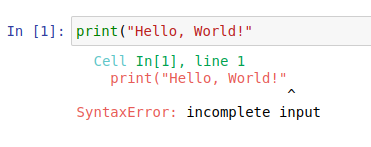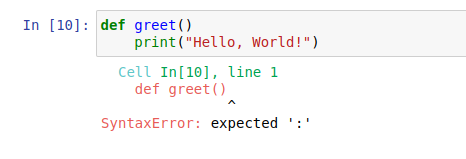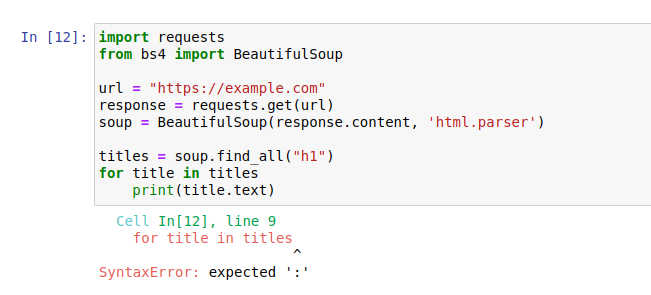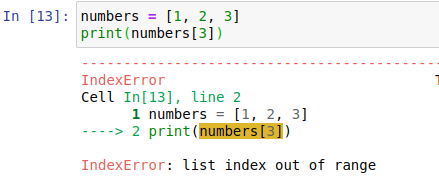
 en
en  Español
Español  中國人
中國人  Tiếng Việt
Tiếng Việt  Deutsch
Deutsch  Українська
Українська  Português
Português  Français
Français  भारतीय
भारतीय  Türkçe
Türkçe  한국인
한국인  Italiano
Italiano  Gaeilge
Gaeilge  اردو
اردو  Indonesia
Indonesia  Polski
Polski Every programming language has a set of rules or grammar it follows. Breaking these rules results in what we call python syntax errors, which can cause your code to fail. These problems happen to everyone—whether you’re just starting out or have been coding for years. If you’ve ever wondered, “what are syntax errors in Python?”. This article covers the most common ones and explains how to fix them while you’re coding.
When a syntax error in Python occurs, it provides a message that points to the problem. This message typically includes:
Let’s take a look at common syntax errors in Python that programmers often encounter.
One of the most common mistakes beginners make is forgetting to close parentheses. This is especially common in function calls and nested structures.
Example:
print("Hello, World!"Іssue message:

Fix:
Ensure all parentheses are correctly closed.
print("Hello, World!")Indentation specifies blocks of the code. Python syntax errors could arise if there is an issue with indentation.
Example:
def greet():
print("Hello, World!")Issue message:

Fix:
Indent the code block properly.
def greet():
print("Hello, World!")Forgetting to include commas between elements in lists or dictionaries is another frequent mistake.
Example:
fruits = {"type": "sweert" "name": "orange"}Іssue message:

Fix:
Add the missing comma between "sweert" and "name".
fruits = {"type": "sweert", "name": "orange"}Using such keywords improperly can also result in syntax issues. Keywords are reserved words that have special meanings.
Example:
class = "Beginner"Issue message:

Fix:
Choose a different name that is not a reserved keyword.
level = "Beginner"Variable names must adhere to specific rules. Using illegal variable names, such as starting with a number or containing spaces, results in Python syntax errors.
Example:
2name = "John"Іssue message:

Fix:
Use a valid variable name.
name2 = "John"Strings must be enclosed in matching quotation marks. Forgetting to close a string results in a syntax issue.
Example:
message = "Hello, World!Іssue message:

Fix:
Ensure the string is closed with the same type of quotation mark.
message = "Hello, World!"A syntax issue can happen if a colon (:) is missing at the end of a compound conditional statement, like if, for, while, or def.
Example:
def greet()
print("Hello, World!")Іssue message:

Fix:
Add a colon at the end of the compound statement.
def greet():
print("Hello, World!")Using operators incorrectly can cause Python syntax errors. This includes assignment operators and comparison operators.
Example:
if x = 10:
print("x is 10")Іssue message:

Fix:
Use the correct comparison operator.
if x == 10:
print("x is 10")Let’s consider a simple web scraping script that encounters any bugs and helps to understand how to fix syntax errors in python built-in debugger, pdb.
Original code:
import requests
from bs4 import BeautifulSoup
url = "https://example.com"
response = requests.get(url)
soup = BeautifulSoup(response.content, 'html.parser')
titles = soup.find_all("h1")
for title in titles
print(title.text)Іssue message:

Fix:
Add the missing colon after the for loop.
import requests
from bs4 import BeautifulSoup
url = "https://example.com"
response = requests.get(url)
soup = BeautifulSoup(response.content, 'html.parser')
titles = soup.find_all("h1")
for title in titles:
print(title.text)Using pdb to debug:
Add the following line before the loop to start the debugger.
import pdb; pdb.set_trace()Add blackout code with break marks:
import requests
from bs4 import BeautifulSoup
url = "https://example.com"
response = requests.get(url)
soup = BeautifulSoup(response.content, 'html.parser')
titles = soup.find_all("h1")
import pdb; pdb.set_trace()
for title in titles:
print(title.text)When you run the script, the pdb debugger will start at the breakpoint.
> /path/to/your/script.py(10)()
-> for title in titles:
(Pdb)Debugging commands:
Example session:
(Pdb) n
> /path/to/your/script.py(11)()
-> print(title.text)
(Pdb) p titles
[<h1>Example Domain</h1>]
(Pdb) c
Example DomainWith pdb, you can continuously step through your program, observe the values of different variables, and comprehend how the code is executed, enabling quick detection and fixing of issues.
Using pdb, you can step through your program, check the values of important variables, and follow the flow of control to track down bugs and logic mistakes. Issues like division by zero, accessing out-of-range items in a list, or using undefined variables are common problems you can catch this way.
Example:
numbers = [1, 2, 3]
print(numbers[3])Іssue message:

Fix:
Ensure you are accessing valid list indices.
print(numbers[2])Try-except blocks let you wrap code that might cause problems. By catching these issues, your program can keep running smoothly even if it encounters syntax mistakes in your code.
Example:
try:
result = 10 / 0
except ZeroDivisionError:
print("You can't divide by zero!")Getting familiar with common mistakes and reviewing examples of syntax errors in Python is something every developer should do. The more you pay attention to diagnostic messages — and the faster you fix them — the smoother your code will run. Use tools and tips that truly support your work.
Comments: 0